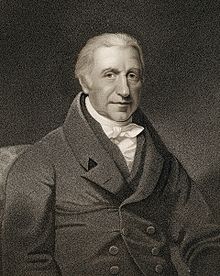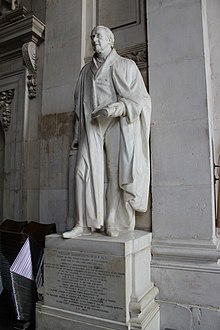William Babington (physician)

William Babington FRS FGS (21 May 1756 – 29 April 1833) was an Anglo-Irish physician and mineralogist.
Life and work
William Babington was born in Portglenone, near Coleraine, Antrim, Ireland. He was the son of Rev. Humphrey Babington, the great-great-grandson of Brutus Babington (sent to Ireland by James VI and I),[1] and his wife Anne (née Buttle). Apprenticed to a practitioner at Londonderry, and afterwards completed his medical education at Guy's Hospital, London, but without at that time taking a medical degree. In 1777 he was made assistant surgeon to Haslar (Naval) Hospital, and held this appointment for four years. He then obtained the position of apothecary to Guy's Hospital, and also lectured on chemistry in the medical school. He resigned the post of apothecary, and, having obtained the necessary degree of MD from the University of Aberdeen in 1795.[2] in 1796 he joined Dr William Saunders at Guy's Hospital in London as his assistant and in 1802/3 (at Saunder's recommendation) replaced Saunders as head Physician.[3]

Babington was physician to
He was the curator for the enormous mineral collection of John Stuart, 3rd Earl of Bute. When Bute died in 1792, Babington bought the collection. The mineral Babingtonite is named after him.
William and Martha Elizabeth Babington were married before 1794, and had four sons and four daughters between 1794 and 1810. Babington died on 29 April 1833 and was buried at St. Mary Aldermanbury in London.[4] He left a son, Benjamin Guy Babington,[5] also physician to Guy's Hospital, and a daughter, Martha, who married the physician Richard Bright.[6]
A statue of Babington by William Behnes (1795–1864) is in St Paul's Cathedral in London.[7]
Selected publications
- "A Systematic Arrangement of Minerals, founded on the joint consideration of their chemical, physical and external characters; reduced to the form of tables." (1796) London, T. Cox.
- "A New System of Mineralogy, in the form of a Catalogue, after the manner of Baron Born’s Systematic Catalogue of the collection of fossils of Mlle Éléonore de Raab". (1799) London, T. Bensley. (Referring to Ignaz von Born's catalogue of the collection of Austrian collector Éléonore de Raab[8])
Further reading
- Munk, William (1878). The Roll of the Royal College of Physicians of London. London: Royal College of Physicians. pp. 451–455. Retrieved 11 March 2008.
- Smyth, George Lewis (1843). Biographical Illustrations of St. Paul's Cathedral. London: Whittaker and Company. pp. 93–94. Retrieved 11 March 2008.
References
- ^ Burke's Landed Gentry of Ireland by Bernard Burke[full citation needed]
- ^ A biography on William Babington, ‘Babington, William (1756–1833)’, sourced from the college archives in King's College London.
- ^ The European Magazine and London Review vol 72 (1817) p.295
- ^ Munk, William (1878). The Roll of the Royal College of Physicians of London. London: Royal College of Physicians. pp. 451–455.
- doi:10.1093/ref:odnb/968. (Subscription or UK public library membershiprequired.)
- doi:10.1093/ref:odnb/977. (Subscription or UK public library membershiprequired.)
- Sinclair, W.p. 472: London; Chapman & Hall, Ltd; 1909.
- .
External links
- A Compendium of Irish Biography. Dublin: M. H. Gill & son.
- Babingtonite
- King's College London Archive Holdings for Babington.
